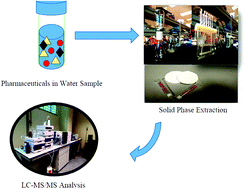Disk solid-phase extraction of multi-class pharmaceutical residues in tap water and hospital wastewater, prior to ultra-performance liquid chromatographic-tandem mass spectrometry (UPLC-MS/MS) analyses†
Abstract
In this work, a new clean-up and pre-concentration method based on disk solid-phase extraction (SPE) was developed to determine multi-class pharmaceutical residues covering a wide range of polarities (log Kow values from −0.5 to 5.1) in water systems, prior to ultra-performance liquid chromatographic-tandem mass spectrometry (UPLC-MS/MS) analyses. Electrospray ionisation in positive and negative modes was used for the simultaneous determination of both acidic and basic pharmaceuticals. The performances of disk SPE and cartridge SPE were compared. The targeted pharmaceutical compounds list included bronchodilators, antidiabetic drugs, antihypertensive drugs, a lipid-lowering agent, analgesics, and anti-inflammatory drugs. Based on our results, the disk SPE demonstrated a higher sensitivity and recovery value and less analysis time as compared to the cartridge SPE method. The limits of detection (LOD) for the new method ranged from 0.02–3.2 ng L−1, 0.02–3.1 ng L−1 and 0.02–4.7 ng L−1 for tap, effluent and influent wastewater, respectively. The method's absolute recovery values ranged from 70% to 122% for tap water, 62% to 121% for effluent wastewater and 62% to 121% for influent wastewater, except for metformin in which the absolute recovery value was approximately 48% for all samples. Intra-day precision for tap water, effluent and influent wastewater ranged from 3–12%, 4–9% and 2–8%, respectively. The method developed was applied for the determination of targeted pharmaceuticals in tap, effluent, and influent wastewater from one hospital treatment plant in Malaysia. The results revealed that the highest concentrations of certain pharmaceuticals were up to 49 424 ng L−1 (acetaminophen) and 1763 ng L−1 (caffeine) in the influent and effluent wastewater, respectively. The results also showed a variation in the treatment efficiencies for the hospital treatment plant from one compound to another. Nevertheless, the removal efficiencies ranged from 0–99%.



 Please wait while we load your content...
Please wait while we load your content...